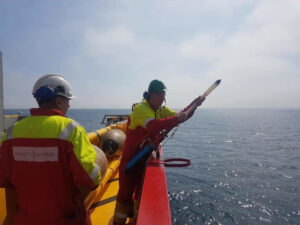In the event of a mechanical failure and accidents a submarine may become unable to surface.
The rescue operations from a distressed submarine (DISSUB) are tasks traditionally performed by Submarine Rescue Diving and Recompression System (SRDRS). They are designed for quick evacuation tasks, able to accommodate up to 16 people. Thanks to the support ship, equipped with a Launch And Recovery System (LARS), it will be transported to the accident site and reach the submarine. SRDRS can efficiently be transported by truck, air or ship.
The SRDRS consists of 3 components, which include the Assessment/Underwater Work System (AUWS); Submarine Decompression System (SDS), PRMS (Pressurized Rescue Module System).
The AUWS component is used to perform localization tasks, assessment of conditions, hatch clearance activities, Emergency Life Support Stores (ELSS) replenishment.
The SDS component comprises two decompression chambers, for the decompression phase.
The PRMS component is a remotely controlled system used for transfer under pressure, it can reach a depth of 2,000 feet for docking and mating with the submarine.
SRDRS uses a combination of state-of-the-art underwater technologies, rapidly mobilized and easily transportable capable of operating in remote and hostile environments.
It is widely recognized that the technology has a key role to play in the submarine rescues tasks that take place in harsh and hostile environment.
Jessica Moro
DSO
Image
Cover: U.S. Navy Pressurized Rescue Module (PRM) […], U.S. Navy Photo by Mass Communication Specialist 2nd Class Thomas Gooley.

